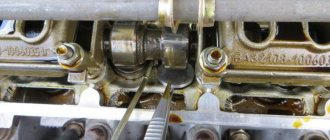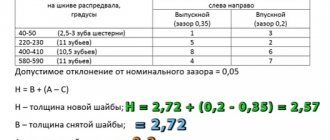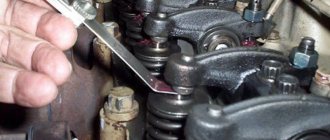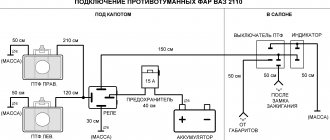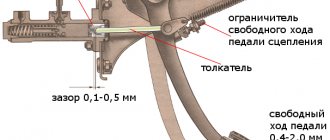Adjustment of valves
If knocking, unstable operation, or increased vibration occur, you should pay attention to the valves.
If the valve timing of the gas distribution mechanism is disrupted, they do not operate accurately, that is, the full volume of gas does not enter the working area of the cylinders, complete combustion of the fuel-air mixture in the working chamber does not occur, and the cylinders are not purged. This is all accompanied by the appearance of a shock load on the camshaft cams on the drive lever and the shaft rod. Fuel and engine oil consumption also increases. What happens if you drive with unadjusted valves? Answer: rapid wear of engine parts, increasing cost and repair time.
Rubber oil deflectors, also known as oil deflectors, also burn out due to a burnt valve cap, which leads to increased engine oil consumption. If the wear of engine parts is large, then it may be better and easier to do an engine swap with your own hands or at a service station.
Even if your engine does not have a belt drive, but a chain drive, then if you do not change the chain before its service life expires, the valves will bend on the piston, as, for example, in the sr20det engine manufactured by Nissan.
Payment
Payment to a Sberbank VISA card The most convenient and profitable payment method for you. Payment can be made through the Sberbank Online system, through a payment terminal (Sberbank ATM), provided that you have a card from this bank. If you are not a client of this bank and you do not have a card, then you can top up your balance at any bank branch through an operator; they will accept cash payment and top up your balance. Commission from 0 to 1%
Cash on delivery (payment upon receipt) Payment for the order will be made at the post office upon receipt of the goods. For cash on delivery services, Russian Post takes an additional commission - approximately 4% of the cost of the order (parcel) upon receipt. In addition to the delivery cost, the post office will also charge you a commission for the cash on delivery service.
Cashless payment This type of payment is suitable for organizations and individual entrepreneurs. An invoice for payment is generated after placing an order. A specialist will contact you to clarify details.
Cash payment You can pay in cash directly in the store, when picking up the goods.
The procedure for adjusting valves VAZ 2101-2107
First we prepare the car:
- wait until the engine cools down if it was running;
- park the car on level ground;
Valve adjustment procedure:
- Remove the air filter cover and the filter itself.
- Remove the air damper control cable (choke).
- Remove the throttle linkage.
- Unscrew the nuts securing the valve cover and remove it.
- Before adjusting the valves, immediately check how the chain is tensioned. If the tension is not normal, you will have to do the work again.
- Remove the distributor cover.
- We install the piston in the 4th cylinder at top dead center (TDC). TDCs are set using marks on the internal combustion engine crankshaft pulley and the camshaft drive cover, and marks are also applied to the camshaft gears and camshaft cover. The mark is set with a special key for the internal combustion engine crankshaft pulley bolt. If you don’t have a key, you can set the 4th piston to TDC by rotating one of the rear wheels. Raise one side with a jack and place the gear shift lever in 4th gear to make it easier to turn and turn the wheel slowly. When setting marks without a key, you will need an assistant to look at the marks.
- When the marks on the camshaft and the camshaft cover are aligned, check that the marks on the crankshaft are also aligned. You can also check whether the marks on the distributor slider match. The contact terminal should be directed to the high voltage wire terminal of the fourth cylinder. We have already discussed how to determine whether ignition is early or late in another article.
- After the marks match, we proceed to adjusting the valve clearances.
The correct procedure for adjusting the valve mechanism of the VAZ “Classic” 2101-2107. Crank angle Adjustable valves 8 and 6 180 4 and 7 360 1 and 3 540 5 and 2
Disconnect the filter mounting tubes and remove the mount.
From the table we see that if the 4th piston is set to top dead center, then we measure and adjust the 6th and 8th valves.
Adjusting valves on a VAZ 2105
A feature of VAZ cars belonging to the “Classic” category, namely the VAZ-2101-2107 model, is the use of power plants that are structurally very similar. The engines of these models differ mainly in some technical characteristics. Thanks to this, many perform maintenance and repair work themselves.
For stable operation of the power unit of these cars, periodic adjustment of the valves is required. It is worth noting that this operation for VAZ “Classic” engines is performed by adjusting the gap between the valve drive lever and the camshaft cam. Since on the “Classic” this operation is performed the same way for different models, let’s consider the sequence of work using the example of one model – VAZ-2105
The adjustment can be carried out both on a cold engine and on a warm one; for this, a 0.15 or 0.20 mm probe is used, respectively.
But for more precise adjustment of the valves, work must be carried out on a cold engine.
Where is the noise coming from?
As the gap grows, the cam hits the rocker, and the driver will hear characteristic noises. These valve clearances must comply exactly with the vehicle manufacturer's recommendations. And noise is just a small part of the many side effects of incorrect clearances. If the valves are worn out, then the rocker itself wears out, and then the camshaft cams. This way, the cam will hit the rocker rather than push it smoothly. Any car owner should know how to adjust valves.
Necessary tool
If you know the sequence of work and have the necessary tools, adjusting the VAZ-2105 valves with your own hands is not difficult. As for the tool, you will need:
- Special key for turning the crankshaft;
- Open-end and socket wrenches (for 8, 10, 13, 17);
- Flat screwdriver;
- Probe with a thickness of 0.15 mm;
- To perform the work, you will need a special wide probe, designed specifically for adjusting valves on VAZ cars.
The material side of the issue
What is the procedure for adjusting the VAZ-2101 valves yourself?
- You need to remove the cover from the air cleaner and take out your air filter. The four nuts are unscrewed with a size 8 wrench, after which you should remove the large bottom hose and the small one extending from the carburetor that go to the air filter.
- Afterwards the air cleaning housing is removed.
- Using a screwdriver and a 8mm wrench, the suction cable is disconnected.
- After removing the spring along with the washer, you need to turn off the gas draft.
- The valve cover is secured with eight nuts, which are unscrewed using a 10 mm socket wrench.
- Next, the lid is lifted.
- Prepare two open-end wrenches (17 and 13), a pre-prepared probe or a special device. Next you need to carry out the operation associated with turning the engine. You need to repeat it until the marks on the crankshaft coincide with the marks shown on the camshaft in the form of stars.
Signs of poor valve clearance
Before describing the adjustment process, you should understand the signs of incorrect clearance, as well as what this leads to. So, the main sign of a broken timing gap is a metallic knock at the top of the engine. Usually this knocking sound initially appears only in a certain operating mode, but over time it will be heard in all modes.
Of course, the gap can either decrease from the nominal value or become larger. Both decreasing and increasing the gap will primarily lead to a loss of power. With a smaller gap, the lever will tighten the valve, which will significantly reduce the tightness in the cylinder and ensure a drop in compression. As a result, this can lead to burning of the valve edge and its seat.
An increased gap will affect the filling of the cylinder combustion chamber, since its opening time will be reduced, and exhaust gas removal will also be incomplete.
To avoid the above problems, it is necessary that the VAZ-2105 valves be adjusted after approximately 15-20 thousand km , as well as at the first appearance of a violation of the thermal clearance.
About choosing styli
Uneven knocking noises in the area of the upper part of the valve cover indicate increased clearances. According to the instructions for setting the VAZ-2106 valves, they can be adjusted. The gaps are changed using special feeler gauges for classic VAZ models. These probes are wide. The standard set of feeler gauges is narrow and cannot cover the entire width of the gap in the operating area of the pressure levers and camshaft cams. This will not allow you to accurately determine whether the gap is correct. On the case in which the dipstick is sold, there is a diagram for adjusting the valves in the form of a convenient table.
Procedure for checking valve clearance
Let's move on directly to the adjustment process itself. First, preparatory work is carried out, which boils down to providing access to the valve levers and camshaft. To do this, remove the air filter housing from the carburetor, the timing belt protective housing, and the valve cover from the engine.
To perform the work correctly, you need to know the procedure for adjusting the VAZ-2105 valves. Interestingly, this procedure is the same for all VAZ cars up to model 2107.
The adjustment begins with the 4th cylinder, located closest to the car interior, while the valves must be counted from the first cylinderlocated near the camshaft drive gear.
Before checking the clearance on the required valves, you need to set TDC on the 4th cylinder. To do this you need to rotate your knees. shaft clockwise until the mark on its pulley aligns with the long mark on the timing belt protective housing. After this, you need to look at the camshaft drive gear; on its inner side there is a mark and a small depression that should coincide with the cast on the cylinder head.
| Marks on the crankshaft pulley | Marks on the camshaft pulley |
Next you need to know the procedure for checking the gap.
- When setting TDC on cylinder 4, the clearances on valves 6 and 8 are checked. Next, the knee is rotated. shaft by 180 degrees, while the camshaft will turn only 90 degrees. For ease of work, the camshaft gear has marks every 90 degrees, corresponding to the TDC of a particular cylinder.
- So, turning the camshaft 90 degrees, set TDC on cylinder 2, while checking the clearance on valves 4 and 7.
- Next, another rotation of 180 degrees is made. knees shaft and aligning the next mark on the camshaft gear with the ebb on the cylinder head, while setting TDC on cylinder 1, and checking the clearance on valves 1 and 3.
- After this, another rotation of the knees is performed. shaft 180 degrees to set TDC on cylinder 3, and the clearance is measured on valves 2 and 5.
Specifics of the work
There is a category of drivers who strive to do all the maintenance and repair work on their car themselves.
This is especially true for owners of domestic cars, and this is commendable.
But such drivers need to realize that a number of works, especially those related to adjustments, require not only theoretical knowledge and experience, but also a kind of “feeling” that comes with time, through trial and error.
Especially such work includes all adjustments carried out on the carburetor, as well as valve adjustment and a number of other adjustments.
Therefore, if you are doing this for the first time, then call a person who has done such work on his car at least 3-5 times, and preferably on the same model as yours.
Also, before carrying out work, check the timing belt tension. It is important.
IMPORTANT: The engine should only be cold, but not lower than 30 - 40C, this is the ideal temperature.
If you have just arrived at the garage and want to adjust the valves on the same day, then it will take about 5-6 hours for the engine to cool down.
You can immediately begin removing the valve covers and other parts; this will reduce the engine cooling time to 1-2 hours, as the heat exchange between the hot engine and the environment will increase.
It’s better to proceed from the principle: arrive in the evening, carry out the work in the morning.
By the way, don’t forget about the gasket under the valve covers; in 90% of cases it has to be replaced, so you should have a new gasket on hand.
Counting cylinders and valves.
The valves are counted as follows. Stand to the left of the car in the direction it is moving, near the engine. Face the engine.
Cylinders and valves are counted from left to right of the timing chain.
The last will be the 4th cylinder and 7.8 valves, but the adjustment begins with valves No. 6 and 8.
Adjusting valve clearance
When measuring the gap, the feeler gauge on each valve should fit between the camshaft and the lever with a little force. If it fits very loosely or is not inserted at all, adjustments are made.
Checking the gap with a feeler gauge
To make the adjustment, the locknut is loosened, then the desired clearance is achieved by rotating the screw, after which the locknut is tightened back. By tightening the locknut, the clearance is checked again. In this way the clearance settings are made on all valves.
How to adjust valves on a VAZ 2105?
The operation of the gas distribution mechanism (GDM) has a significant impact on both the completeness of fuel combustion and the level of cylinder compression. A particularly important role is played by the timing valves, which create that very compression, allowing the fuel to show its full energy potential. Like any other mechanisms, valves require periodic maintenance, that is, VAZ 2105 valves need to be adjusted.
When should adjustment be made?
It all depends on the experience and skills of the driver. If the owner of the five knows all the whims of his vehicle and knows how to ensure a competent driving process, then the valve clearance will need to be checked and adjusted no more than 25,000 (km). If the vehicle is in the hands of an inexperienced driver, then valve adjustment on the VAZ 2105 can be carried out after 10,000 - 15,000 (km).
Signs of improper valve operation
- The presence of extraneous noise when the engine is running. The noise is concentrated in the upper part of the internal combustion engine. Extraneous sound can appear at a certain speed or at all speeds (this is already an advanced case). That is, when you hear a suspicious knock in the timing belt, immediately look for the procedure for adjusting valves 2105 and begin repairs.
- Noticeable loss of power. A valve that is not tightly pressed does not allow the optimal degree of compression of the cylinder to be created, which is why the piston is pushed out with incomplete force. A pressed valve that is not pressed in time does not allow full release of exhaust gas, which reduces the efficiency of the next detonation stroke of the combustible mixture. If you feel a lack of traction power, feel free to look for information on how to adjust the VAZ 2105 valves and start adjusting the timing belt.
Features of timing belt
For example, the gas distribution mechanism - with the upper position of the valves and camshaft. shaft The timing drive of the engine was carried out via a chain, and this is on all models.
A special feature of the valve mechanism is the use of push levers, also known as rockers. They are located between the camshaft and the end of the valve stem. That is, the cam acts on the valve not directly, but through the rocker. Also, thanks to the push lever, it is possible to adjust the thermal gap.
This gap is needed in order to compensate for the change in the geometric parameters of the constituent elements of the valve mechanism that occurs as a result of heating, during which the metal expands. If this gap did not exist, then after heating the power plant there would be a violation of the valve timing. To put it simply, when heated due to the expansion of the metal, the valves do not close completely, which leads to loss of compression and, as a result, a drop in power.
The list of maintenance work for the power plants of these models included such an operation as adjusting the valves. This is due to the design features of the valve mechanism. During operation, the working surfaces of the valve end, rocker and camshaft cams are erased, which leads to a violation of the thermal clearance.
Fortunately, the same design is quite simple, so the adjustment work is quite simple and you can do it yourself. It is only important to know the order of work and the sequence of adjusting the valves on the “Classic”. It is noteworthy that the operation is identical for almost all models, so the procedure for adjusting the valves of the VAZ-2101 and, for example, the VAZ-2105 is the same, only in the VAZ-2107 it is slightly different.
Since for most models the operation is done identically, then all Zhiguli models belonging to the “Classics” will appear below.
The first and basic rule of the operation is that it is performed only on a cooled engine. This is due to the same expansion of the metal. If the valve adjustment on a VAZ-2102 or any other model is done on a heated unit, then the operation will not give a positive result, because when it cools, the metal will return to its original shape and the gap will not correspond to the norm, it will simply increase.
You also need to know when the VAZ-2105 valves should be adjusted. A sure sign that the valve mechanism is out of adjustment is a loud metallic knock from the engine compartment when the engine is running. Moreover, its intensity changes in proportion to the increase or decrease in speed.
Adjustment of valves on the VAZ-2104 must also be carried out every time repair work is carried out on the cylinder head associated with removing the camshaft.
Procedure for adjusting valve clearance
It should immediately be noted that it is best to adjust the operation of the valves when the engine is cold. This will allow you to more accurately diagnose and adjust the operation of the timing belt. So, let’s let our top five cool down thoroughly after the last race. The road will stand overnight, and in the morning you can begin repairs.
So, the valve adjustment itself on the VAZ 2105:
- We get under the hood, remove the air filter housing, the timing belt guard and the valve cover. For this task we will need a set of open-end and ring wrenches (8,10, 13 and 17).
- We pay attention to the 4th cylinder (it is closest to the driver). It is necessary to move its piston to the top dead center (TDC) position. To do this, take an open-end wrench 17 and rotate the crankshaft pulley clockwise until the TDC mark on the pulley coincides with the mark on the casing body (immediately behind the pulley). Let's look at the further procedure for adjusting valves 2105.
- Let's move on to the camshaft drive gear (on the opposite side). There is a mark on its pulley, make sure that it coincides with the pointer on the head of the blocks (as in the photo).
- From this point on, we move on to checking the valve clearances. TDC on the 4th cylinder allows you to check and adjust, if necessary, valves numbered 6 and 8.
- We turn the crankshaft (by the pulley, with a key) 180°, while the camshaft pulley will only turn 90°. This will set TDC on the 2nd cylinder. The VAZ 2105 valves numbered 4 and 7 are being checked and adjusted.
- Rotate the crankshaft 180° again. The VTM of the 1st cylinder will be installed. We control and adjust valves numbered 1 and 3.
- We turn the crankshaft 180° again to set TDC on the 3rd cylinder. We work with valves 2 and 5.
Marking the camshaft pulley
By the way, here is a video of valve settings:
Valve lid
Owners of the VAZ 2105, like other classic models, often encounter the problem of an oily engine. An unpleasant situation can manifest itself in the form of both small and significant leaks, which indicates failure of the valve cover gasket. Replacing the seal is not a complicated undertaking and will require a minimum of effort and tools, such as:
- flat screwdriver;
- wrench 10;
- ratchet wrench 10.
Replacing the valve cover gasket on a VAZ 2105
We carry out the work of replacing the valve cover seal on the “five” in the following sequence:
- To free access to the cover, remove the air filter and the housing, which is attached to the carburetor.
Valve cover tightening procedure
To avoid distortions when installing the valve cover, the nuts must be tightened in a certain order, as can be seen from the figure below.
The appearance of any malfunctions or even their signs associated with wear of the valve seals or the valves themselves should not be ignored. If you replace a failed part or make the necessary adjustments in a timely manner, you will be able to avoid costly engine repairs. Therefore, it is important to monitor the technical condition of the power unit and perform the necessary maintenance according to the manufacturer’s recommendations.
vote
Article rating
How to adjust the gap between the valve and the cylinder block?
- We use a probe with a thickness of 0.15 (mm). It should fit under the valve with a slight tension (neither strong nor weak). If the dipstick falls into the gap or, on the contrary, does not fit, then from this moment the adjustment of the valves on the VAZ 2105 begins.
- We loosen the lower lock nut with one key, and with the second key we turn the valve stroke screw (up or down, depending on the result of checking with the feeler gauge).
- Tighten the locknut without much fanaticism.
- We do a control check with a feeler gauge at 0.15 (mm).
I hope the instructions are clear and understandable.
Additional Information
After adjustment, we assemble all the engine elements into place (valve covers, timing belt cover, air filter housing).
We make a test drive and listen to the sound. At this point, independent maintenance of timing valves can be considered successfully completed.
Please note that the VAZ 2105 is a classic of the bygone Soviet automobile industry. The classic line also includes the VAZ 2101, VAZ 2102, VAZ 2103, VAZ 2104 and VAZ 2106. Starting with the VAZ 2107, cars use an injection system for preparing the combustible mixture. That is, seven is no longer a classic. The procedure for adjusting valves 2105, as well as 2101, 2102, 2103, 2104 and 2106, is completely the same. That is, the classics are configured according to the same principle.
Starting from the VAZ 2107, you need to configure the timing in a different way. Valve adjustment on the VAZ 2107 is carried out at a more subtle level. Only a properly qualified car mechanic can handle this work. Without solid experience in handling vehicles, it’s better not to go into the timing belt of VAZs, starting with the seven. It’s easier to take the car to the nearest service station.
I hope the article on how to adjust valves on a VAZ 2105 was useful. Have smooth roads and fewer breakdowns.
The VAZ 2103 engine is a transitional version of the third generation engine
By analogy with previous modifications of the internal combustion engine line, the VAZ 2103 engine retained the overhead camshaft position. The engine power has been increased, the attachment is rotated by a belt, the chain remains only on the timing sprocket.
Technical characteristics of the engine 2103
In the third ICE 2103, the manufacturer AvtoVAZ returned the original cylinder diameter of 76 mm and increased the volume of the combustion chamber, so the technical characteristics of the engine are as follows:
class B – 76.01 – 76.02 mm
How the VAZ-2105 valves are adjusted
Owners of domestic cars have long gotten used to the idea that VAZ cars are easy to drive and relatively simple to repair.
Therefore, it is preferable for drivers to choose their own hands for these works rather than the experience and knowledge of service station employees. This decision is fully justified, and everyone is happy: the car is intact, the driver is confident in his abilities, money is saved. But such zeal often leads to new breakdowns, imbalances within the technical part of the machine, and other troubles. Therefore, in order to begin even a small and seemingly simple repair, you need to have an adviser on hand. Let's consider the procedure and conditions of repair work if the time has come to adjust the valves on the VAZ-2015. But before you start practicing, a little theory and preparation.
Preparation
Adjusting the valves of the VAZ-2105 is not the most tricky and difficult task. Of course, when you do any car repairs yourself for the first time, it is always exciting and often very difficult.
But you shouldn’t panic, because VAZ has always made cars for people, the circuits of which can be easily understood on their own (especially if the driver has already dealt with other models in the series).
First of all, you will need to prepare your tools.
- It is necessary to prepare a whole carload of open-end and socket wrenches of various diameters (from 8 to 17).
- In addition, the most important attribute of the work will be the key for working with the shaft. Without it, it will be impossible to correct the operation of the valves.
- Repairs are carried out on any engine condition - cold and warm. It's a matter of urgency and convenience. But in any case, for work you will need a probe with a thickness of 0.15.
- Armed with the necessary tools, you can safely begin diagnostics.
What's the problem with the valves?
The concept of “adjustment” is that a specialist should restore the original clearances of the power unit.
The signal for the need for repairs is a sound - tapping when the engine is running. As a rule, with minor changes in the gap, knocking is present only at the beginning, and then under certain loads. But over time, the condition worsens and the knocking becomes constant. You can miss it at first. But over time, when the noise becomes constant, even an inexperienced driver should not miss it. The problem can be not only an expanded, but also a narrowing of the gap. The balance of the engine is set during assembly so that all the internal combustion power is transferred to the pistons at a certain pressure and speed. The gap (no matter which way it changes) will introduce an imbalance into the operation of the machine, which promises a drop in power under loads necessary for powerful operation.
Renovation begins
When the problem is identified, it is possible (and even necessary) to begin repairs. To get to the valve levers themselves, you have to do some preparatory disassembly that will give access to the camshaft.
- The first point for this will be the injector, since this is where both the engine air valve and the protective housing are located, which must be removed, like other belt protection.
- All shields and covers also need to be removed, since it is necessary to work in a comfortable manner, since despite the relative simplicity, the work is still delicate.
The operating scheme will be familiar to all owners of VAZ cars up to version 2107. The adjustment procedure (as well as the operation of the power unit as a whole) is the same for cars in this series. Therefore, there will be no surprises in the repair. The valve numbering order starts from the gear, closer to the camshaft. Repairs need to start from the fourth (the one closest to the car interior).
As for the adjustment itself, it is important to be as careful as possible. You don't need rulers or calipers for this. There are marks everywhere on all parts that have anything to do with the operation of the valves. It is necessary to observe their coincidence. The mark on the crankshaft must match the mark on the protective belt housing. But before this, the TDC 4 valves should be adjusted.
It is better to look at the gaps every 15-20 thousand mileage (at the same time you need to pay attention to the carburetor, cleaning of which also contributes to the stable operation of the car). But since a car is a practical matter, a description alone will not do. Below you can clearly see how the valves are adjusted.
With your own hands or a service station
Having become familiar with how the VAZ-2105 valves are adjusted, the driver can calmly make a decision.
If he does not have time or does not want to rely on his limited experience, then the above recommendations and advice, which seem overwhelming, will allow him to turn to the service station with a pure soul and not be afraid that the money is wasted. On the other hand, there is nothing fundamentally difficult about the replacement, so the driver can easily cope with the above instructions on his own. All you need for a good repair is determination and attentiveness and, of course, preventive maintenance of the entire car system. The main thing is to remember that a working car means safety for both the driver and other road users.
